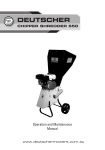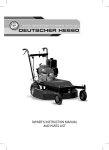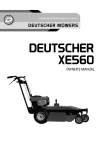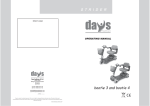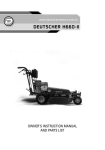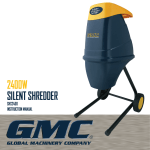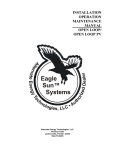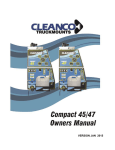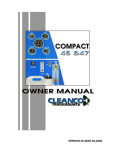Download Deutscher GARDEN CHIPPER 750 Specifications
Transcript
DEUTSCHER GARDEN CHIPPER 750 Operation and Maintenance Manual www.deutschermowers.com.au INDEX 5 General Description 6 Initial Assembly 8 Safety Procedures 10 Decals 11 Storage & Transporting 12 Pre-Start Checks & Starting 13 Chipping 15 Basic Maintenance 17 Detailed Maintenance 19 Exploded View Drawing 20 Parts List 24 Warranty & Contact Details 3 GENERAL DESCRIPTION Hopper Engine fuel cap Engine oil fill hole/ dipstick under cap Belt guard Discharge chute Engine oil drain Infeed chute Base frame Clutch lever Chipping chamber The Deutscher Garden Chipper 750 was designed as a garden chipper that is capable of chipping palm fronds and similar vegetation, but will also chip green hardwood branches to 65mm diameter, dry hardwood to 25mm diameter and dry softwood to 50mm diameter. The chipper can be fitted with a Briggs and Stratton Intek 6.0 or a Honda GX200 engine. For ease of use, there is only one entry point for material on this machine. One of our primary design aims was to produce a machine that self feeds with most materials. This reduces the time taken when chipping and also improves operator safety, as it is less likely the operator will need to push material into the hopper. The cutting device (rotor) of the Garden Chipper 750 is a 395mm diameter, 8mm thick steel disk with twin tool steel chipper blades bolted to its surface. To eliminate the possibility of material wrapping around the drive shaft and then causing premature bearing failure, both rotor bearings are mounted behind the disk. The chipper blades are reversible to give twice the life, and they can be rotated in the field should they become blunt. A clutch has been fitted to allow easy starting. Also the discharge chute can be locked in the raised position to reduce storage space and enable access through gates and shed doors. For your safety, a switch is provided on the discharge chute to prevent the machine being started with the chute raised. 5 INITIAL ASSEMBLY The following instructions apply when the unit has not been assembled. Tools required: • Two13mm ring / open ended spanners. (or one 13mm spanner plus a ratchet wrench and 13mm socket) • One open ended 17mm spanner. 1. NOTE: Do not put oil into the engine until the unit is assembled. 2. After lifting the box from the pallet, remove the loose contents from around the chipper. There should be: a. Two wheels. b. An axle assembly c. The discharge chute d. A plastic bag containing this manual, two axle ‘E’ clips and four 16mm axle washers, two 10mm nyloc nuts and two 10mm washers for the hopper, and two 8mm bolts plus two 8mm nyloc nuts and four 8mm washers for attaching the discharge chute. There is also an M8 x 20 bolt plus an 8mm spring washer and an 8mm flat washer for securing the discharge chute. 3. Place a 16mm washer on each end of the base frame axle then put the two wheels on the axle followed by another washer on the outside of each wheel. Push the 2 ‘E’ Clips into the grooves in the ends of the axle. 4. You will need a second helper for this stage. Remove the four 8mm bolts that are through the brackets attached to the wooden pallet. With assistance, lift the chipper from the pallet and lower it onto the axle assembly, with the four upstanding tabs located between the front and rear plates of the chipper. See below. Plastic belt guard Infeed chute 5. Secure the chipper to the base frame using the four 8mm bolts and nuts that were securing it to the pallet. 6. Attach the hopper to the infeed chute using the two 10mm nuts (17mm spanner) and two 10mm plain washers. NOTE: The large ‘DEUTSCHER’ decal on the hopper should be on the engine side, see photo on the front of this manual. 6 INITIAL ASSEMBLY 7. Attach the discharge chute to the machine with the two M8 x 20 bolts, two plain washers and two 8mm nyloc nuts as shown below. Tighten the nyloc nuts fully, then back off half a turn. This will allow the chute to hinge open and closed. Check that the chute is latching correctly in the ‘UP’ position and that the microswitch audibly clicks when the chute is being lowered into its operating position. DO NOT DROP THE CHUTE WHEN UNLATCHING. HOLD ONTO THE OUTER END AND LOWER IT DOWN. Discharge chute 8. A third M8 x 20 bolt plus an 8mm plain washer and an 8mm spring washer have been provided for locking the chute in the operating position. With the chute lowered, place the spring washer then the plain washer onto the bolt, and insert the bolt through the slot at the base of the chute and into the nut that is welded inside the chassis. 9. With the chipper on a level surface, fill the engine with 600mm of the correct engine oil. Check the level by using the dipstick. See the engine manual, supplied. Add unleaded petrol to the fuel tank. WARNING: WHEN HANDLING PETROL, KEEP AWAY FROM ANY NAKED FLAMES, THIS INCLUDES THE PILOT LIGHT ON GAS APPLIANCES. PETROL FUMES ARE HIGHLY VOLATILE. 7 SAFETY PROCEDURES WARNING: Become familiar with this booklet before starting or operating the chipper. PREPARATION 1. Do not allow children to operate this equipment. 2. Do not operate this equipment in the vicinity of bystanders. 3. Do not run the unit in an enclosed area since the exhaust from the engine contains some carbon monoxide, which is a colourless, odourless, tasteless and poisonous gas. 4. Wear safety glasses and hearing protection at all times when operating the machine. 5. Avoid wearing clothing that is loose fitting or has hanging cords or ties. 6. Only operate the machine in open space, not close to a wall or other fixed object, and on a firm, level surface. 7. Do not operate the machine on a paved or gravel surface, where ejected material could cause injury. 8. Before starting the machine, check that all screws, nuts, bolts, and other fasteners are properly secured and that guards and covers are in place. 9. Replace damaged or unreadable labels. ( See ‘Decals’ section - page 10) 10. Use extra care in handling fuels. They are flammable and the vapours are explosive. The following points should be observed: • Use only an approved container. • Never remove the fuel cap or add fuel with the power source running. Allow engine and exhaust components to cool before refuelling. • Do not smoke. • Never refuel the machine indoors. • Never store the machine or fuel container inside where there is an open flame, such as a gas water heater, pilot or burner. • If fuel is spilled, do not attempt to start the power source, but move the machine away from the area of spillage before starting. • Always replace and securely tighten the fuel cap after refuelling. • If the fuel tank is drained, this should be done outdoors. 8 SAFETY PROCEDURES OPERATION: 1. Before starting the machine, look into the hopper to ensure it is empty. 2. Keep your face and body away from the feed intake opening. 3. Do not allow hands or any other part of the body or clothing inside the hopper, the discharge area, or near any moving part. 4. Keep proper balance at all times. Do not overreach. Never stand at a higher level than the base of the machine when feeding material into it. 5. Always stand clear of the discharge area when operating the machine. 6. When feeding material into the machine, be extremely careful that pieces of metal, rocks, bottles, cans or other foreign objects are not included. 7. If the cutting mechanism strikes any foreign objects or if the machine should start making any unusual noise or vibration, shut off the power source and allow the machine to stop. Disconnect the spark plug wire from the spark plug and take the following steps. • Inspect for damage. • Check for, and tighten, any loose parts. • Have any damaged parts replaced or repaired with parts of equivalent specifications. 8. Do not allow processed material to build up in the discharge zone; this may prevent proper discharge and may result in kickback of material through the feed intake opening. 9. If the machine becomes clogged, shut off the engine, disengage the clutch (lower the lever) and disconnect the spark plug wire before clearing debris. 10. Keep the engine clear of debris and other accumulations to prevent damage to the engine, overheating or a possible fire. 11. Keep all guards and deflectors in place and in good working condition. 12. Do not tamper with the engine governor settings; the governor controls the safe maximum speed and protects the engine and all moving parts from damage caused by over-speeding. Seek authorised service if a problem exists. 13. Do not move the machine while the engine is running. 14. Shut off the engine using the electrical switch whenever you leave the work area. 15. Do not tilt the machine while the power source is running. 16. Even when wearing safety glasses, do not look into the hopper, while the machine is running. Material may be ejected at high speed. 9 DECALS The decals shown below are attached to each new machine. It is the operators responsibility to ensure these decals are in place and legible. They can be purchased from Deutscher Mowers Pty Ltd as a set. See ‘Parts List ’ - page 20, in this manual. On the top under underneath the discharge chute. Part No. 3350 On the side of hopper. Part No. 3498 On belt guard near clutch lever. Under the engine, on the curved surround. On the top of the infeed chute, near the engine On the hopper side of the chassis, near the discharge chute. Part No. 3503 On the front of the hopper. Part No. 3346 10 STORAGE & TRANSPORTING STORAGE Always allow the machine to cool before storing. Store the machine in a dry area away from children and where petrol vapours cannot be ignited by a spark, such as a welder, or a flame from say the pilot light in a gas appliance. When storing the unit for longer than three months, it is a wise practice to run the fuel tank dry beforehand. Fuel can lose volatiles and becomes ‘stale’ when left in the tank. This may prevent starting in the future. TRANSPORTING Warning: As stated above, never move the unit when it is running. 1. To move the unit around the garden, stand at the back of the unit facing the lowest edge on the top of the hopper. Grasp the hopper by both sides using both hands, and pull the top of the hopper towards you until the unit is evenly balanced over the rear wheels. Push the unit forward; ensuring it remains evenly balanced over the rear wheels. Try not to descend steep slopes, and maintain a secure footing if you are descending slopes. NEVER DESCEND A SLOPE WITH A BYSTANDER BELOW YOU. Do not traverse across steep slopes. The unit may fall sideways. 2. Do not attempt to move the unit up or down stairs unless you are capable of holding the weight. Always proceed slowly down stairs with the unit below you. Lower the unit onto each step carefully, to avoid high impact loads on the wheels and axle. When climbing stairs, again ensure the unit is below you, and walk backwards holding both sides of the hopper firmly. 3. Transporting from one location to another is best accomplished using a trailer behind a car, or a utility. Always tie the unit in place securely. To prevent the unit falling over, it is safer to remove the hopper. KEEP THE UNIT UPRIGHT, AS OIL WILL SPILL OUT OF THE ENGINE THROUGH THE EXHAUST OR THE CARBURETOR, IF IT IS TILTED SIGNIFICANTLY. 4. To move through garden gates, doorways etc. remove the 8mm bolt at the base of the discharge chute, using a 13mm spanner. Raise the discharge chute until it locks in position. When lowering the chute, hold onto the outer end of the chute and raise the red handled latch rod. Lower the chute (DO NOT DROP IT). Before using the machine again, replace the 8mm bolt in the base of the discharge chute. This bolt is provided for your safety, as the chipper will not stop instantly should the chute be raised. 11 PRE-START CHECKS & STARTING PRE-START CHECKS • Ensure you are wearing safety glasses and hearing protection. • Avoid wearing loose fitting clothing. • Place the machine on a level ‘dirt or grass’ surface. • Check that all fasteners on the machine are secure and all guards are in place. • Check engine oil level. • Ensure the hopper and the chipping chamber are clear. • Keep bystanders away. • Follow safety instructions (page 9) when filling the fuel tank. STARTING (See engine diagram below) 1. Disengage the clutch. Push the lever fully down.. 2. Turn the fuel tap to ‘ON’. 3. Switch on the ignition. 4. Push the throttle lever to ‘FAST’. (Rabbit) 5. Move the choke control to ‘CHOKE’.( Generally not necessary if the engine is hot.) 6. Stand facing the engine control panel and to the right of the panel. With your left hand holding the top of the hopper and your right hand holding the starting cord handle, swiftly pull the starting handle to the right. Repeat until the engine starts. If the engine seems to be flooded, you may need to try a few pulls of the starter with the choke fully off. 7. As soon as the engine fires, start reducing the choke setting. 8. Once the engine sounds stable, and the choke is fully off, slowly raise the clutch lever until it reaches the end of its stroke. 9. Check that the rotor is spinning by looking down inside the hopper. If it is not spinning, maintenance is required. (See ‘Maintenance’ section - page 15). 10. Reduce the throttle setting to the position you need for effective machine operation. Large diameter branches or a heavy shredding load will require full throttle. IMPORTANT: The clutch is fitted to make starting easier. It may not fully disengage the drive to the rotor, especially when the drive belt is new. NEVER rely on the clutch to disengage the drive. CHOKE FUEL TAP THROTTLE ON-OFF SWITCH 6.0 STARTER HANDLE Control Panel Layout (B&S) 12 Control Panel Layout (Honda) CHIPPING CHIPPING WARNING! Do not place hands or fingers into the discharge opening. Keep bystanders away from the machine when it is operating. Never leave the engine running and unattended. WARNING! In general, material will ‘self fed’ into the hopper. Do not push material down into the hopper with your hands. Use a light green branch (no larger than 20mm diameter) or a piece of softwood. If material is jammed, a safer practice is to turn off the machine, remove the offending material, restart and feed it in again. WARNING! Wear eye protection and hearing protection. Although every effort has been made to reduce the velocity of chips that may fly back up the hopper, we could not test every variety and shape of wood. It is therefore a wise operating practice to keep your head out of the opening. WARNING! Be extremely careful that you do not inadvertently collect metal, bottles or other hard objects when you gather material to drop into the hopper. The hard material may fly back, or it may even break components inside the machine. 1. The Deutscher Garden Chipper 750 can chip palm fronds of any size that will fit through the feed opening inside the bottom of the hopper. Palm fronds with a wide end should be fed end first, otherwise a short piece of material may be left jammed at the bottom of the hopper after the remainder of the frond is shredded. To chip fronds with ends that will not fit through the base opening, simply cut off the large end with a bow saw. 2. If the engine is slowing significantly as a branch is being processed, check that the throttle is set to ‘Fast’ and allow the disc to reach full speed before starting the next branch. Alternatively, the material being chipped may be very dry and hard, or the chipper blade may need sharpening. See maintenance instructions. 3. If the processed material is not being cut satisfactorily, the blades may need sharpening. 4. Material other than palm fronds can also be chipped. As a guide, we recommend that the maximum size of GREEN hardwood branches is 65mm (2 ½”) in diameter and DRY hardwood branches is 25mm (1”) diameter. Similarly, we recommend that the maximum size of DRY softwood is 50mm (2”) in diameter. We strongly recommend wearing leather gardening gloves when processing dry material, as they can reduce jarring when holding the end of the branch. 5. Should the chipper appear to be running correctly but the processing rate drops, stop and check the belt tension as described in the Maintenance section. Continuing to run with a slipping belt will cause premature failure of the belt. Alternatively, material may be jammed against the anvil in the base of the hopper. In this case, switch off the engine, push the clutch lever fully down, remove the spark plug lead then remove the plastic hopper (take off the two 10mm nuts on each side). Carefully prise the jammed material from the base of the opening and at the same time check that the blades are still sharp. Re-sharpen blunt blades as described in the Maintenance section. 13 CHIPPING CHIPPING (continued) 6. If you wish to collect the shredded material, it can be discharged onto a plastic, or similar, sheet. To collect the material, simply switch off the machine, move it backwards off the sheet, and pick up the sheet by its four corners. Please note: The machine should not be tilted while it is running, as the engine may seize. 7. Do not allow discharged material to build up to the point where the discharge chute is blocked. In the unlikely event that material becomes jammed in the chipper chamber, switch off the machine, turn off the fuel tap, lower the clutch lever and disconnect the spark plug lead from the spark plug. Latch the discharge chute in the ‘Up’ position and reach into the discharge opening to remove the offending material. WARNING: FAILURE TO FOLLOW ALL THESE PROCEDURES COULD LEAD TO A SERIOUS INJURY, AS THE ENGINE MAY START WHEN THE DISC IS ROTATED BY HAND. 8. Be very careful when feeding long ‘stringy’ material into the hopper, as it can rush out of your hands in an instant. NEVER WRAP MATERIAL AROUND YOUR HANDS. ALWAYS BE PREPARED TO INSTANTLY RELEASE THE MATERIAL. PREFERABLY, LONG MATERIAL SUCH AS VINES SHOULD BE CUT INTO LENGTHS NO LONGER THAN 500mm. SAFE STOPPING PROCEDURE TO STOP, SIMPLY MOVE THE ON-OFF SWITCH TO ‘OFF’. NEVER RAISE THE DISCHARGE CHUTE TO STOP THE MACHINE. REMOVE THE SPARK PLUG LEAD BEFORE CLEARING A JAM OR CHECKING THE MACHINE. LEAVE THE CLUTCH ENGAGED WHEN STOPPING. THIS WILL REDUCE THE ‘RUN-ON’ PERIOD OF THE ROTOR. After the rotor has stopped, the clutch can be moved to the disengage position in readiness for the next start-up. 14 MAINTENANCE BASIC MAINTENANCE Tools required : • 5mm Allen Key (chipper blade replacement) • Two 13mm ring / open ended spanners. (or one 13mm spanner plus a ratchet wrench and 13mm socket) • 17mm open ended spanner for hopper removal. General When the machine is stopped for servicing, inspection, or to change an accessory, shut off the engine, push down the clutch lever, disconnect the spark plug wire from the spark plug and make sure that all moving parts have come to a complete stop. Due to the magneto starting system, the engine may start when the cutting means is moved unless the ignition switch is off and the spark plug wire is removed from the spark plug. Never rely on the clutch to positively disengage the drive mechanism. Allow the machine to cool before inspection, adjustments etc. Oil check and replacement The engine oil level should be checked regularly, every 4 hours of operation. For oil replacement, see the engine manual. Air filter cleaning Check the condition of the air cleaner regularly, in dusty conditions every 4 hours. See engine book for cleaning details. Drive belt adjustment / replacement The drive belt may become loose after an initial settling in period, after very heavy loads have been applied or after an extended period of use. You can tell if the belt is slipping by a reduction in material feed rate or by the belt smoking. When ‘slipping’ is suspected, do not continue to use the machine. Tighten the belt as follows: • Switch off the engine and remove the spark plug lead from the spark plug. • Using a 13mm spanner, remove the plastic belt guard. • Observe the condition of the belt. If it is severely frayed or has a burnt section, it will need to be replaced. 12mm deflection (3) (1) (2) Drive Belt DRIVE BELT ADJUSTMENT 15 MAINTENANCE Drive belt adjustment / replacement (contd) • If the belt is in good condition, loosen the nut (1) furthest from the belt on the threaded rod attached to the clutch lever, using a 13mm open-ended spanner. See sketch below. • With the clutch lever in the ‘fully down’ position, wind the nut (1) about 2mm away from the adjacent boss (3), then wind the other nut (2) outwards until both nuts are firmly in contact with the boss. • Raise the clutch lever fully and check the belt tension. The far side of the belt should deflect about 12 mm when pushed firmly inwards. See sketch on page 15. • If the belt is not yet tight, repeat the process. • Should you run out of adjustment, the belt will need to be replaced. • Tighten both nuts against the boss, then replace the plastic belt guard. Do not overtighten the belt guard nuts, or you will distort the guard. • To replace a belt, simply lower the clutch lever and wind nut (2) fully inwards. Replace the belt by winding it onto the two pulleys. IMPORTANT: ENSURE THAT THE BELT IS INSIDE THE TWO BELT GUIDES THAT ARE ATTACHED TO THE SIDE PLATE OF THE ENGINE. FAILURE TO CHECK COULD RESULT IN A RUINED BELT. Chipper blade replacement/ sharpening The chipper blades will become blunt with extended use, particularly if you are chipping dry hardwood. You can feel when the blades are blunt, as the processing time is longer and the engine is more likely to slow down under heavy loading. To sharpen the blades: • Switch off the engine and remove the spark plug lead from the spark plug. • Using two 13mm spanners, remove the two 8mm nuts that secure the sloping cover plate (above the discharge chute) and the M8 bolt and nut that secure the side cover plate (adjacent to the sloping cover plate). Remove both plates. • With the clutch lever disengaged, turn the rotor until one chipper blade is opposite the opening created by removing the covers. Providing the disc is not rotated by hand, you can re-engage the clutch to hold the disc in position, while removing the blade. • Using a nail or a similar sharp object, clean the allen key holes in the three countersunk screws that retain the chipper blade. • With the 5mm allen key on the outside and a 13mm spanner on the inside, remove the three screws that secure the chipper blade to the rotor disc. • Remove and inspect the chipper blade. The sloping edge can be sharpened at 40 degrees to the top surface using a fine grinding wheel. Remove only a minimum of material, until you feel that the edge is sharp. Initially the blade is 45mm wide. With repeated resharpening, the blade will reach 40mm wide. At this time it should be replaced. Turn the disc and repeat the removal and sharpening operation for the second blade. Try and keep both blades the same width to ensure the rotor stays in balance. • Before refitting the chipper blades, clean the surface of the disc behind the blades and ensure that the blades sit flat on the sloping machined surface. Replace the retaining screws if they appear worn or damaged. Always use new 8mm nyloc nuts and tighten them securely. DO NOT USE PLAIN 8MM NUTS. THE CHIPPER BLADE COULD FLY OUT OF THE CHAMBER OR SMASH INTO THE ANVIL IF THE BOLTS BECOME LOOSE. • Once the blades are securely bolted, rotate the rotor disc slowly by hand, and check that both chipper blades do not hit the anvil that is at the base of the hopper. • Replace the maintenance cover plates. 16 MAINTENANCE DETAILED MAINTENANCE Tools Required: • 5mm Allen Key • 8mm ring spanner and a ratchet wrench with 13mm and 17mm sockets. • 16mm open ended spanner or equivalent shifting spanner. • 9/16 AF open ended or ring spanner (For disc removal only) • 3/8” open ended spanner. (Pulley removal) • Soft headed hammer. General The rotor assembly should be inspected after every 50 hours of use or after a solid impact, by removing the sloping cover plate above the discharge chute, removing the belt cover and then the drive belt (as described on pages 15 & 16). While turning the rotor drive pulley rapidly (by hand) and observing the edge of the rotor disc, you should be able to detect any measurable bend in the disc assembly. If the side movement is greater than 1mm each way, the machine will need to be dismantled. Dismantling the chipper for engine replacement and rotor repair/ replacement. • Switch off the engine, turn off the fuel tap and remove the spark plug lead from the spark plug. • Remove the hopper. • Disengage the clutch, remove the belt cover and the drive belt. • Remove the engine by firstly unplugging the lead from the microswitch (the plug is on the side of the engine near the clutch handle), then removing the four bolts securing the engine to its base plate. Lift the engine off the unit. • Remove the discharge chute. • Remove the four screws attaching the chassis to the base frame, then (with assistance) lift the unit from the base frame. • Remove the ten 10mm nyloc nuts that join the two halves of the chipping chamber together. • Gently tap the two halves of the chassis apart, using a soft hammer or similar and working around the chassis in stages. Disc replacement Complete the dismantling described above. • Remove the three 3/8” UNC nyloc nuts from behind the rotor disc using a long 9/16 AF open ended or ring spanner and a 5mm Allen Key. • Gently tap the rotor assembly from the end of the rotor spindle. • Remove the chipper blades as described above. • Remove the fan blades using a 5mm allen key and a 13mm spanner. • When replacing the disc, first attach the fan blades and ensure they are oriented as shown below. • Attach the replacement disk to the spindle. Use new 3/8” UNC countersunk screws if the rotor was damaged, as they may be weakened. The countersunk screws are threaded into the disc. Ensure they are fully tightened with the 5mm allen key before attaching NEW 3/8” UNC nyloc nuts. HOLD THE SCREWS FIRMLY WITH THE ALLEN KEY AS THE NYLOC NUTS ARE TIGHTENED, OTHERWISE THE DISC WILL BE LOOSE ON THE SPINDLE. 17 MAINTENANCE Spindle Removal/ replacement. Complete the Disc removal procedure described above. • Remove the pulley from the outside end of the spindle first loosening the two boss screws with a 3/8” open ended spanner. Note: A puller may be needed to remove the pulley from the shaft, if it wont come off with gentle tapping/ levering. BE VERY CAREFUL NOT TO BEND THE PULLEY FLANGES. • Using a soft hammer, tap the spindle shaft on the ‘pulley’ end and it should move out of the bearings. • Inspect the bearings for signs of overheating, loss of grease, looseness or ‘lumpy’ operation when turned. Also inspect the fit of the bearings in the housings. They must be a very firm sliding fit. Replace the bearings if they are visibly worn. NOTE When re-assembling, ensure the shoulder on the spindle shaft is hard against the inside bearing. Next, the pulley boss must be positioned fully in against the outside bearing, with the boss screws on the outside of the pulley. Ensure the boss screws are opposite the flats machined on the spindle end, and apply a thread locking compound to the boss screws before tightening. Chipper re-assembly Basically, re-assembly is the reverse of the procedures listed above. However, after assembly, check that the chipper blades do not contact the anvil at the base of the hopper by rotating the rotor by hand. SPARE PARTS On the next page of this booklet is an exploded view drawing of the chipper and on the following pages you will find an associated parts list. These parts can be purchased through your local dealer. See Website www.deutschermowers.com.au or telephone 03 5339 5708 for the location of your nearest dealer. 18 EXPLODED VIEW DEUTSCHER GARDEN CHIPPER 750 Exploded View 1 2 6 5 7 8 3 4 10 9 11 16 6 36 20 7 14 5 8 14 18 8 64 25 28 29 8 21 65 37 30 31 36 36 31 30 34 27 24 23 64 27 8 44 56 36 59 47 8 44 14 36 49 48 57 43 35 14 41 13 46 66 8 40 36 39 38 32 6 44 8 8 8 14 22 26 23 19 33 62 23 13 12 8 14 58 15 17 8 61 63 36 14 60 42 50 45 6 43 54 14 14 8 51 53 8 52 44 55 14 14 8 8 19 COMMONLY USED SPARE PARTS DEUTSCHER GARDEN CHIPPER 750 Exploded View Parts 20 Item No. Part No. Part Description Qty per 1 3450 Hopper assembly 1 2 3451 Handle Pipe 2 3 3497 Screw pan head 5mm 4 4 1260 5mm Nyloc nut 4 5 3123 Chute attach plate assy 2 6 1177 10mm Nyloc nut 12 7 1059 10mm plain washer zp 2 8 1099 M8 Nyloc nut 38 9 3122 Coach bolt 4 10 3186 Engine Intek 6.0 1 10 3204 GX200 Honda 1 11 3162 KEY 3/16" x 37mm 1 12 3446 Engine Pulley assembly 1 13 1521 Set screw for pulley 3 14 1019 8mm Plain washer 21 15 1018 8mm Spring washer 2 16 3495 Belt guide, rydal bar 2 17 1100 Bolt 5/16" UNF x 3/4" 2 18 3014 Engine Bolt 4 19 3448 B40 belt 1 20 3460 Front plate welded assembly 1 21 3473 CSK HT Rotor bolts. 3 22 1062 3/8unc Nyloc nut 3 23 3178 Screw CSK M8 HT 10 24 3475 Chipper blade kit Inc bolt & Nuts 2 25 3472 Chipper disc 1 26 3470 Spindle assembly 1 27 1898 Spindle bearing 2 COMMONLY USED SPARE PARTS DEUTSCHER GARDEN CHIPPER 750 Exploded View Parts Item No. Part No. Part Description Qty per 28 3484 Latch rod plastic sleeve 1 29 3481 Latch rod 1 30 3482 Star lock clip 2 31 3483 Rubber grommet 2 32 3487 Micro switch 1 33 3514 B/S wire assembly inc earth 1 33 3513 Honda wire assy inc earth wire assy 1 34 3492 4mm Nyloc nut 2 35 3491 Microswitch screw 2 36 1017 Bolt M8 x 20 12 37 3432 Discharge chute assembly 1 38 3486 Microswitch bracket 1 39 3437 Rear Plate, Welded Assembly 1 40 3494 Rear belt guard metal 1 41 3479 Star Washer 2 42 1646 6" Pulley assembly 1 43 3170 8mm Allthread 2 44 1072 M8 Nut 6 45 3449 Belt guard 1 46 3427 Clutch rod plastic sleeve 8mm 1 47 3435 Clutch lever 1 48 5028 E clip (10mm) 1 49 1328 Bolt, idler arm pivot M8 x 50 1 50 3168 Stepped bush, idler pivot 1 51 1118 M8 bolt x 45, idler pulley axle 1 52 3169 Belt tensioner adjuster 1 53 3172 Stepped pivot, clutch mechanism 1 21 COMMONLY USED SPARE PARTS DEUTSCHER GARDEN CHIPPER 750 Exploded View Parts 22 Item No. Part No. Part Description Qty per 54 3164 Idler pulley arm assy 1 55 3163 Idler pulley 1 56 3428 Welded base frame 1 57 3153 Wheel, Rim ZP12, golf buggy tyre 2 58 1314 Circlip 2 59 1315 5/8” Washer 4 60 1118 M8 bolt x 35 1 61 3455 Maintenance cover, side plate 1 62 3456 Maintenance cover top plate 1 63 1342 M8 x 25 bolt 2 64 3474 Angle iron fan blade 4 65 3478 Removable anvil 1 66 3436 Clutch control rod assy 1 3452 Instruction Manual 1 3454 Decal Set - 750 Chipper 1 NOTES WARRANTY POLICY • DEUTSCHER MOWERS PTY. LTD. will repair or replace, free of charge, any chipper or part of a chipper that is defective in materials or workmanship (or both) for a period of 24 months from the date of purchase. If parts or units are replaced, the replacement period will be no longer than 3 months. This does not cover normal wear, abuse or incorrect service procedures as set out in the owner’s manual. Parts such as blades, blade bolts, wheels and v-belts, which can be subjected to use beyond their normal intended working limits, are also excluded. • This warranty is void if parts other than genuine parts have been used or if repairs or modifications have been made without the manufactures written authority. • This warranty does not obligate the manufacturer, agents or dealers to cover transport costs incurred in the repair or replacement of any defective part. Also, it does not obligate the manufacturer, agents or dealers to cover any other costs associated with making the warranty claim. (eg telephone calls) • The engine on this chipper is covered by the engine manufacturer’s warranty supplied with the mower. For your nearest engine dealer, phone: - Honda M.P.E.: 1300 2 466 32 - Briggs & Stratton: 1300 274 447 www.briggsandstratton.com To claim a warranty the owner must return the chipper (at the owners expense) to an authorized dealer , then give the authorized dealer a clear explanation of the defect. A list of authorized dealers can be found on the Deutscher Mowers website or the location of the nearest authorized dealer can be determined by telephoning the telephone number listed below. Our goods come with guarantees that cannot be excluded under Australian Consumer Law. You are entitled to a replacement or refund for a major failure and for compensation for any other reasonably foreseeable loss or damage. You are also entitled to have the goods repaired or replaced if the goods fail to be of acceptable quality and the failure does not amount to a major failure. The benefits to the owner given by this warranty are in addition to other rights and remedies of the owner under a law in relation to goods or services to which the warranty relates. FOR YOUR RECORD Model: GARDEN CHIPPER 750 Serial Number: Date of Purchase: Mower Purchased From: Remember: Proof of purchase is the responsibility of the owner and is necessary prior to warranty work being undertaken. Only warranty work performed by an authorized dealer using genuine spare parts will be eligible for payment, and claims may not be accepted if abuse or other damage has occurred that is not considered as normal wear and tear. Manufactured in Australia by: DEUTSCHER MOWERS PTY LTD, 731Creswick Rd, Ballarat, 3350 Telephone : 03 5339 5708 Part No. 3452 Edition: 1 MAY 2013 Fax: 03 5339 3189 www.deutschermowers.com.au
























